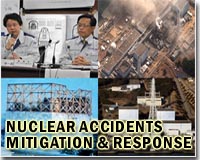| . |  |
. |
Tokyo (AFP) April 12, 2011 Japan upgraded its month-old nuclear emergency to a maximum seven on an international scale of atomic crises Tuesday, placing it on a par with the Chernobyl disaster a quarter-century ago. The reassessment to a "major accident" with "widespread health and environmental effects" was based on the total radiation released, which officials said was one-tenth of the 1986 accident in the then Soviet Union. Prime Minister Naoto Kan, however, also stressed that "step by step, the reactors in the Fukushima Daiichi power plant are moving toward stability. The level of radioactive materials released is declining." "We have caused a great deal of trouble for the world," the centre-left premier added in a televised press conference, stressing that "we must make efforts to increase the safety of nuclear reactors". As workers continued their struggle to stabilise the charred reactors, Japan was rocked by more aftershocks from the 9.0-magnitude quake on March 11 that sent a massive tsunami barrelling into the northeast coast. By the latest count the tectonic disaster, the country's worst post-war crisis, had killed more than 13,000 people and left over 14,500 others missing. Around 150,000 people are still in emergency shelters. In the latest of a series of recent quakes, a powerful 6.3-magnitude tremor struck Fukushima prefecture on Tuesday afternoon, forcing the temporary evacuation of nuclear plant workers and rattling buildings in Tokyo. Explosions rocked the reactor buildings in the days after the quake, but a senior government official who asked not to be named said that now "the biggest threat is definitely aftershocks and tsunamis." More than 400 aftershocks stronger than 5.0-magnitude have hit since March 11. The reassessment on the UN's International Nuclear Events Scale (INES) came as Japan prepared to evacuate more people living near the plant, extending the 20-kilometre (12-mile) exclusion zone to take in several towns further afield. Level seven accidents on the INES scale involve a "major release of radioactive material with widespread health and environmental effects requiring implementation of planned and extended countermeasures." Each level on the scale indicates a roughly 10-fold increase in severity. The previous rating of five had placed the unfolding disaster at the tsunami-hit Fukushima plant northeast of Tokyo on the same level as the 1979 Three Mile Island accident in the US state of Pennsylvania. Despite the upgrade, nuclear safety agency official Hidehiko Nishiyama said there were marked differences between the Chernobyl and Fukushima accidents. "In Chernobyl, there was acute exposure to a high level of radiation, and 29 people died from it," he said, referring to the initial radiation deaths within the first days and weeks. "This is not the case in Fukushima." The official also said that while in the Chernobyl accident the reactor had exploded, "in Fukushima... the reactors themselves have stayed intact, although we are seeing some leakage". Reassurances were given by the UN's atomic watchdog Tuesday that the two disasters were different despite having the same rating. "This is a totally different accident. The level of releases and the value for Chernobyl are significantly different," said Denis Flory, head of nuclear safety and security at the International Atomic Energy Agency. The World Health Organisation said that health risks outside the exclusion zone of the failed Fukushima Daiichi nuclear plant have not augmented, even though Japanese authorities upgraded the emergency. France's nuclear safety agency said the accident had released "significant" amounts of radiation but at levels "not comparable" to Chernobyl. However, an official for operator Tokyo Electrical Power Co. (TEPCO) said that "the radiation leak has not stopped completely and our concern is that it could eventually exceed Chernobyl", media reports said. Nuclear experts looking at Fukushima have said that partial meltdowns took place when reactor cooling systems failed, causing a series of explosions that leaked radioactive material into the atmosphere. Tens of thousands of residents were evacuated from the 20-kilometre exclusion zone and people in a further 10-kilometre band have been advised to stay indoors. On Monday the government said it would order several other communities further afield to leave due to concerns over long-term exposure to radiation, but that a uniform extension of the zone was not appropriate. In a phone call to Kan, China's premier Wen Jiabao reiterated a request that Japan "promptly and accurately inform China" of developments in the nuclear crisis, China's state-run Xinhua news agency reported. Low levels of radiation have been detected in China, and its government last week extended an import ban on food and produce from parts of Japan near the plant. The head of the Climate and Energy Unit at Greenpeace in Germany, Thomas Breuer, accused the global nuclear industry of "underplaying the human consequences of this terrible tragedy," warning more radiation damage could be to come.
Share This Article With Planet Earth
Related Links Bringing Order To A World Of Disasters A world of storm and tempest When the Earth Quakes
 Japan minister visits stricken nuclear plant
Japan minister visits stricken nuclear plantTokyo (AFP) April 9, 2011 Japan's industry minister on Saturday met workers battling to cool overheating reactors and plug radioactive leaks in the first government visit to the country's tsunami-crippled nuclear plant. The visit came as one of the country's top nuclear officials called for a sweeping review of safety standards in the industry and Tokyo warned the crisis at the plant was far from over. Industry m ... read more |
|
| The content herein, unless otherwise known to be public domain, are Copyright 1995-2010 - SpaceDaily. AFP and UPI Wire Stories are copyright Agence France-Presse and United Press International. ESA Portal Reports are copyright European Space Agency. All NASA sourced material is public domain. Additional copyrights may apply in whole or part to other bona fide parties. Advertising does not imply endorsement,agreement or approval of any opinions, statements or information provided by SpaceDaily on any Web page published or hosted by SpaceDaily. Privacy Statement |